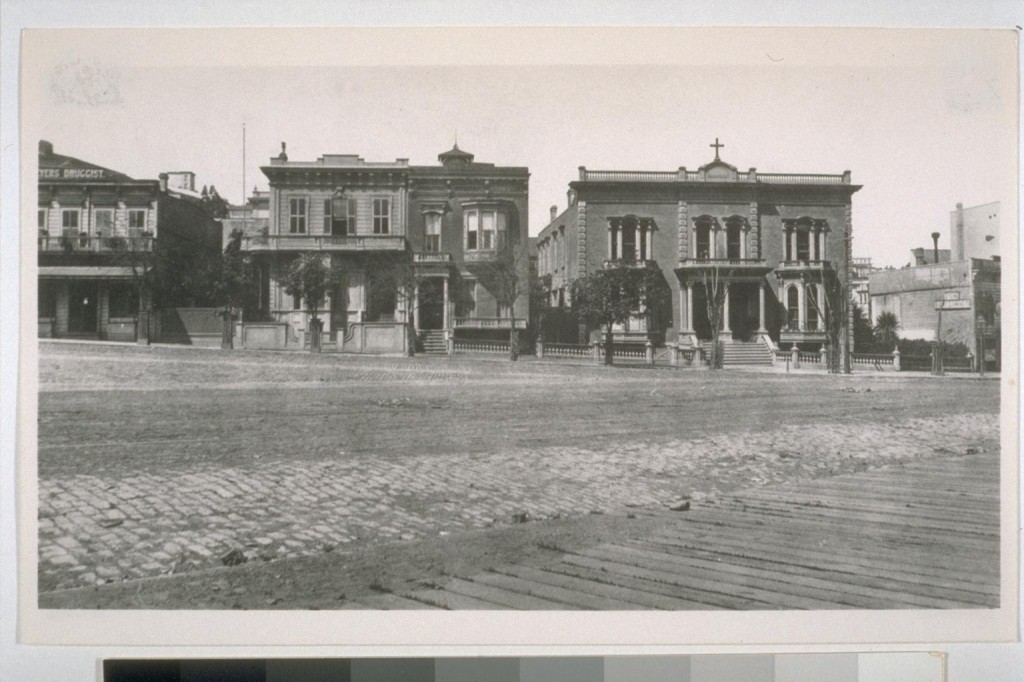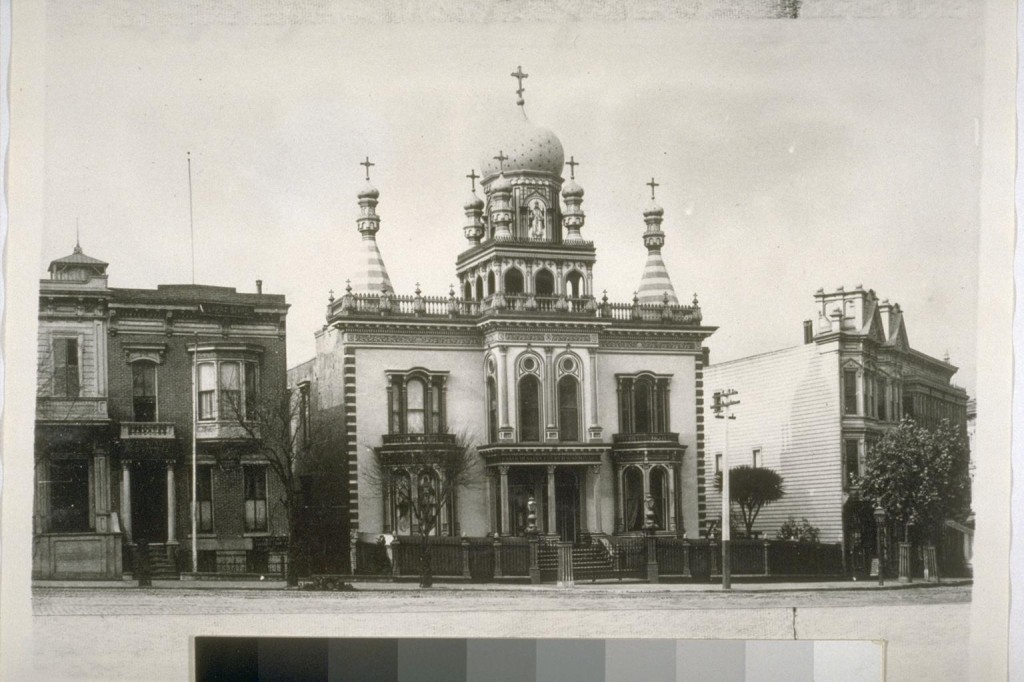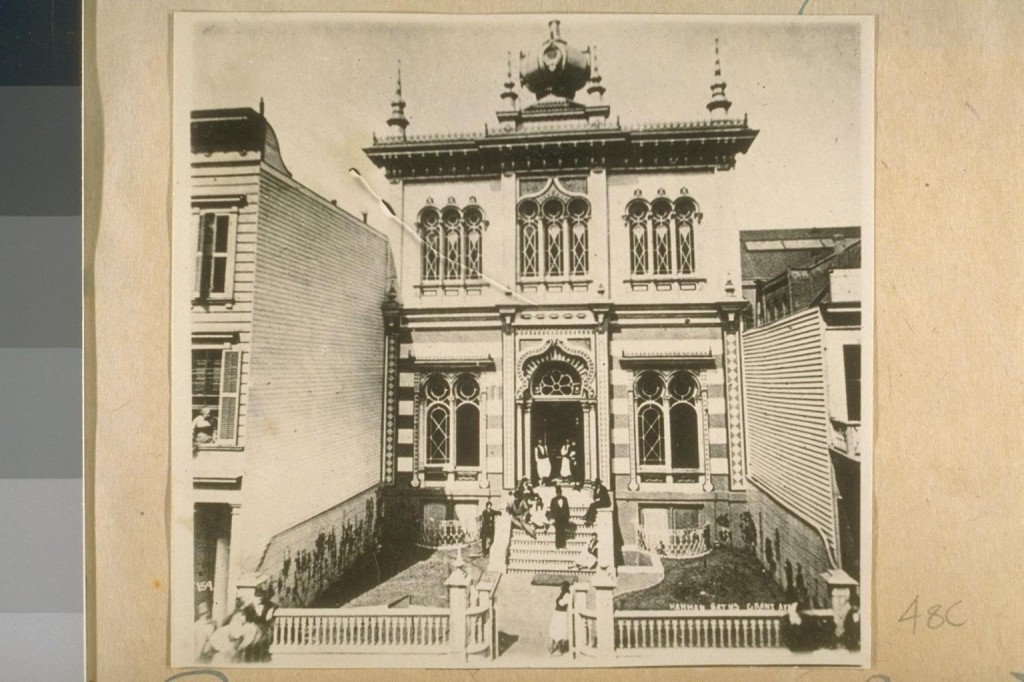In its early years, the Russian cathedral in San Francisco had a number of homes, including:
- 3241 Mission St. (the home of a parishioner named Mr. Seculovich)
- 509 Greenwich St.
- 911 Jackson St.
- 1108 Pierce St.
- 829 Greenwich St. (owned by a German Lutheran church)
- 1713 Powell St.
Most of those buildings were occupied for only a few years each, but in the Powell St. location, the cathedral found a long-term home. They took up residence there in 1881, and remained at that address until the 1906 earthquake. The present cathedral was built on Green St., in 1909.
In 1889, the Powell St. cathedral was seriously damaged in a fire, and had to be completely renovated. There were all kinds of conspiracy theories about the cause of the blaze, and many parishioners suspected arson. This took place in the middle of the Bishop Vladimir scandals. I’ll talk about those scandals, and the fire itself, another time. Today, I want to present a rather exciting new discovery — photos of the Powell St. cathedral both before the fire, and after the 1889 renovation.
Here is the “before” shot, taken sometime in the 1880s:

Russian cathedral at 1713 Powell St. (right), San Francisco, prior to the 1889 fire. (Photo from the Roy D. Graves Pictorial Collection, Bancroft Library, University of California at Berkeley)
And here is a photo of the cathedral after the renovation. This latter image is from sometime in the 1890s:

The Powell St. cathedral after the 1889 renovation. (Also from the Roy D. Graves Pictorial Collection at Berkeley)
The latter photo appears in the 1975 OCA book Orthodox America: 1794-1976, but I don’t know if any Orthodox are aware of the existence of the earlier image. Taken together, these two photos clearly show how dramatic the 1889 renovation was.
UPDATE: I had erroneously said that the Powell Street cathedral was occupied until 1909. In fact, it was destroyed in the 1906 San Francisco earthquake. I’ve corrected the above text to indicate this.
In the comments, Fr. Andrew Damick posted a link to another photo of the post-1889 Powell St. cathedral. It appears to be from the back of the church, and it’s such a great shot that I have to post it here:

That’s a pretty dramatic church following the renovation. Is the post-1889 Powell St. cathedral still an Orthodox church today?
Unfortunately, the Powell Street cathedral was destroyed in the 1906 earthquake. (I mistakenly said, in the article, that it was occupied until 1909, but I should have said 1906, and will make this correction.)
Here‘s another shot, probably post-renovation (perhaps from the back?).
Based on that photo, the church on Powell was between Filbert and Union Streets. A Google Maps check shows that the building seems to be no more.
Wow, Fr. Andrew, that’s a great photo. If you don’t mind, I’d like to add it to this post.
I proudly wear my skills as a GoogleNinja on my cassock sleeve, but you certainly don’t need my permission to put that photo into this post.
I just came across a description of the Cathedral and Church in “The Overland monthly””The Greek Church on the Pacific” in 1895 :
http://books.google.com/books?id=UMARAAAAYAAJ&pg=RA1-PA480&lpg=RA1-PA480&dq=kostrometinoff+san+francisco&source=bl&ots=ohPtQEfRDT&sig=do_0h7NS6yV4Hdbxb91yQZgxGdw&hl=en&ei=BEqTTaKWEsmB0QGtq-jMBw&sa=X&oi=book_result&ct=result&resnum=8&ved=0CCsQ6AEwBw#v=onepage&q=kostrometinoff%20san%20francisco&f=false
“The Bishop now lives at San Francisco, his cathedral being the church of St. Basil. The building, having been adapted from an ordinary house, is not a very good specimen of a Greek church: though its decorations are elaborate. The walls are covered with enlargements from famous pictures in the churches of Russia. On the south side of the ikon-stand is a picture of St. Basil the Great, kneeling in the robes of a bishop at the altar painted by the noted Russian artist Dumitrashko. Another painting represents St. John Chrysostom, holding a two-branched candelabrum in one hand and a cross in the other: and there is a picture of Jesus showing the imprints of the nails and the hole in his side to the doubting Thomas. On the north side are pictures of the Holy Virgin, of St. Nicholas proclaiming his faith at the Ecumenical Council, and of St. Innocentius, the Bishop of Siberia. In the nave or body of the church is the copy of an old ikon of the Virgin of Tichoin in Novgorod; it is of silver-gilt. In the altar space is the bishop’s throne. Bishop Vladimir was succeeded in 1892 by Bishop Nicolas, the present incumbent of the see. Bishops, being generally monks, have only one Christian name.”
The article begins with a picture of the interior of the Cathedral in SF, and includes a history, current financial informatino etc.
In view that the Orthodox Church is the largest in AK, which has the largest proportion of Orthodox of any state, the following is amusing;
“Speaking generally, it may be said that, except among the Aleuts, who have become thoroughly Russianized, the Russian Church never acquired any strong hold upon the natives of Alaska. Many of the Aleuts write and speak Russian, and are able to follow’ the church services, which are conducted in the old Slavonian language. But the preaching of the Russian clergy, with the exception of Veniaminof, made very little impression on the savage Koloshes and Kadiakers, who retain mos’t of their old superstitions and practise Shamanism to the present day. The Kadiakers have had missionaries among them since 1794, but they show little interest in religious observances. Under Baranof’s administration the priests were held in scant respect, even by their own countrymen. During the sermons the rough traders and hunters squatted down and smoked, and sometimes even laughed so loudly that the priest could not go on with his duty. The priests baptized a few natives every year, and visited such of the villages as were situated near to the trading-posts, but they did very little to spread the word of God or to help and comfort the poor in their hours of suffering and distress: nor did they make any serious efforts to induce the natives to adopt more settled and industrious habits. Sir George Simpson and other travelers accuse them of being: hard drinkers, and Mr. Dall mentions one, who, after serving for seven years as a missionary on the Yukon, thanked God, that he was about to return to Russia, where a glass of rum could be bought for twenty-five kopecks.
Yet on the fog-begirt Pribylof islands and in other dreary parts of the vast territory of Alaska, the brilliant services and numerous festivals of the Greek Church lend a few touches of brightness to the hard, dull lives of the natives, and help to save them from utter stagnation.”
The Russians are long gone, but the Orthodox have been here to stay.
Fascinating. I’ve never seen a photo of the old SF cathedral’s interior. Too bad the article’s author took such a negative view of Orthodoxy in Alaska.